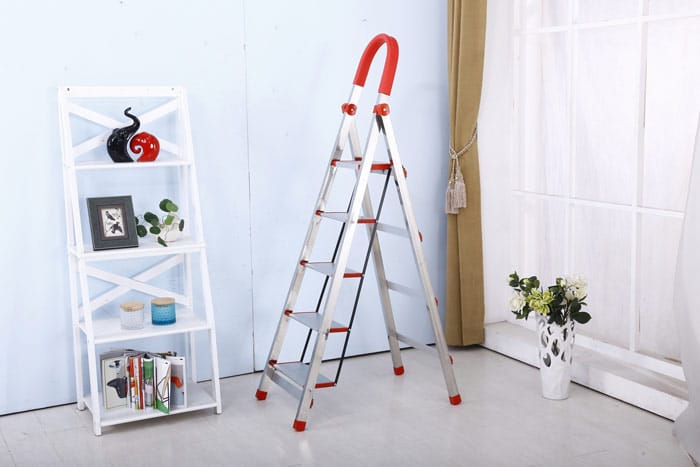Sometimes you need a safe and reliable ladder to repair or reach something. Step ladders are a perfect choice when you don’t have to climb high: they’re ideal for changing a light bulb, washing windows, or taking things from high cabinets.
Of course, if you need to climb higher you can opt for a multi-use ladder but you have to take all the necessary precautions to avoid accidents. What are those? In this post, I’ll show you all the important ones.
Although you can find a large selection of ladders in stores and online as well, sometimes it’s not easy to choose the one that’s best suited for older adults. So how can you find a safe ladder for seniors?
Before buying, answer these questions:
- How tall should your ladder be?
- Is portability important?
- Will you use the ladder mostly indoors or outdoors?
- Is there any chance that you’ll make any contact with electricity while on the ladder?
- How much do you weigh?
- Do you often lose balance or feel dizzy?
Note: A safe ladder won’t prevent falls and accidents without proper usage.
Make sure you also check out our comprehensive article about the most important home safety measures (with a downloadable checklist).
Basic Ladder Safety Rules for Seniors:
- Always inspect the ladder before using it. Look for cracks, loose screws, missing parts, and stability issues. If the ladder is contaminated with any slippery substance, like oil or water, clean it before climbing it.
- Do not climb a ladder without having someone nearby who can help you out if something goes wrong. If you still have to climb alone, make sure you have a medical alert device with you so that you can reach out for help in case you would need any assistance. We’ve written about the best medical alert watches here.
- Do not place ladders in front of doors.
- Set up the ladder on a firm, even ground.
- Before climbing, make sure the ladder is opened fully and locked.
- Always have three points of contact with the ladder when climbing it to prevent sudden falls and slips: either two hands and one foot or two feet and one hand should always be in contact with the ladder.
- While using the ladder face it constantly and do not overreach the side rails.
- Never stand above the third highest step of the ladder.
- Step ladders are not recommended to lean up against the wall, even in a closed position.
- Use non-slip footwear. Also, the feet and treads of the ladder should be slip-resistant.
- Don’t carry heavy objects when climbing the ladder, always climb slowly, and don’t make any sudden movement: it can result in losing your balance.
- Never climb a ladder in high winds.
- Do not move the ladder until climbing down.
Keep in mind: climbing a ladder is never without risks, even if you have a safe one. Only do it if it’s really necessary. If you have mobility or balance issues, ask someone to do the job for you. Also, if you feel tired, stay off the ladder. Most seniors should not use ladders on stairs. If they do, extreme caution is required.

Features to Look for When Buying a Safe Ladder for Seniors
- Opt for a ladder that’s lightweight and portable but has the proper weight capacity.
- Folding ladders are usually more stable than extension ones.
- Choose a model that has anti-skid feet and non-slip, extra-large treads.
- Handrails attached to the side rails make climbing a much easier and safer process.
- If you’re planning to use the ladder mostly outdoors opt for a stainless and weatherproof model.
- An attached tray can be very useful for holding tools that you need while being on the ladder.
- If you may contact electricity, use a wood or fiberglass ladder instead of a metal one. Fiberglass and wood ladders are non-conductive and they’re a great choice to avoid electric shock.
- Use a ladder with UL (Underwriters Laboratories) Seal. UL certification means that the product is tested for safety and approved by UL which is a nonprofit safety organization.
Recommended Models
To tell the truth, there aren’t many safety ladders to choose from that are suitable for seniors. In my opinion, the best and most reliable one is this model on Amazon. It’s sturdy and stable and comes with handrails and large, anti-slip treads. I like that it’s easily foldable and that its feet don’t scratch the floor.
If you need a fiberglass ladder (that’s nonconductive and safe if you’re working around electricity) I definitely recommend you check out this model from Gorilla Ladders. Although it doesn’t have handrails like the first model I mentioned above, it’s very stable and durable (has an ANSI Type I rating). Also, it’s simple and comfortable to use due to the large standing surface. I like that this one is also foldable, so it doesn’t need much space to store.
Falls are rather common among seniors, however, in most cases they’re preventable. Check out our best fall prevention tips for seniors here.
If you need a reliable ladder for painting, make sure you also check out this article for the best models.
Related Questions
What is the correct angle for a ladder?
Ladder safety starts with a proper setup. Of course, stepladders can be opened at a fixed angle, so the answer applies mainly to extension ladders. For every four feet of height between the ground and the top of the ladder keep one foot distance from the wall: that’s equal to 75 degrees. This is also called the four-to-one rule.
How to store ladders?
The proper storage of the ladder is important to avoid taking up too much space and injuries due to bumping into it. Probably the best way to store your ladder is to hang it on the wall horizontally in the garage or the pantry. You can do this by installing hooks on the wall.
If you don’t want to bother with hooks, you can just lay the ladder down horizontally on the floor next to a wall. Just make sure it’s not a tripping hazard and it’s out of the way.
What types of ladders exist?
Basically, there are three types of ladders: step ladders, extension ladders, and multi-use ladders. Step ladders are A-shaped, foldable ladders that usually have a maximum height of 6 feet. For most indoor purposes they’re the best choice for seniors.
According to ANSI Classification:
Type I – Construction and Industrial: Heavy duty with 250 – 375 lbs. load capacity.
Type II – Tradesman and Farm: Medium duty with less than 225 lbs. load capacity.
Type III – Household: Light Duty with less than 200 lbs. load capacity.
For maximum safety, it’s recommended to use type I ladders, even for household purposes.
What are they made of?
Ladders are usually made of aluminum, wood, or fiberglass. Aluminum ladders are pretty popular because of their durability and lightweight. Their downside is that they conduct electricity. Wood and fiberglass ladders are nonconductive. Wood ones are heavier, fiberglass ones are more expensive than those made of aluminum.
Is a step stool useful for the elderly to make getting into bed easier?
Yes, it can be useful. However, before buying make sure the step stool has non-slip feet and surface. Choose a model that’s sturdy enough and has the proper weight capacity.
Don’t forget that a step stool can be a tripping hazard so it’s a good idea to slide it under the bed when not in use to avoid falls and accidents.











